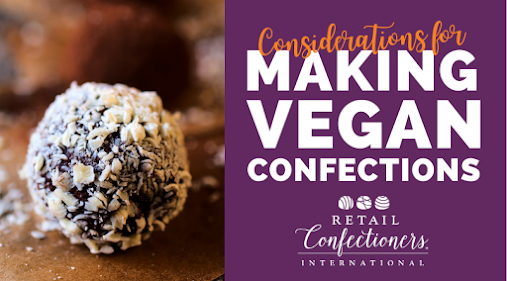With veganism growing in popularity, you might be considering how to appeal to this consumer group. In a past issue of RCI’s Kettle Talk
magazine, Randy Hofberger, with R&D Candy Consultants shared the following considerations for making vegan confections.
It's important to first understand and identify the challenges that may come along with adapting your recipes to meet vegan requirements and expectations. According to vegan.org, in order for a product to be approved for vegan certification:
“It must not contain meat, fish, fowl, animal by-products, eggs or egg products, milk or milk products, honey or honey bee products, insects or products from insects such as silk or dyes, or sugar filtered with bone char."
In addition to the guidelines mentioned above, the perception of what makes a product vegan must also be considered. While a refined sugar that is decolorized without bone char can be used, unrefined sugar or coconut sugar (even better) are preferred. Likewise, brown rice syrup is also preferred over corn syrup. As a general rule, the use of organic and non-GMO/bioengineered ingredients are also preferred.
After evaluating your ingredients and identifying necessary substitutions, the next step is to acquire assurances from suppliers that the ingredients you plan to use are considered vegan.
Next, understand the challenges alternative ingredients may present and how to avoid them, if possible. Although alternative sugars, like coconut sugar, can replace refined sugar/sucrose, they do present their own challenges. For example, coconut sugar has a darker color (making it difficult to get a white cream center), stronger flavor, is less sweet and more hygroscopic. Replacing corn syrup with another syrup might be less of a challenge as long as it has the same dextrose equivalent (DE) and is clarified. Unclarified syrups, such as brown rice, however, may give "off" cereal flavors to your candy.
When replacing the cream in a formulation, the first step is to look at the composition of the dairy cream—typically 36–40% fat and 55% moisture. Coconut cream has about 20% fat and 70% moisture. While you won't be able to do an exact component replacement, balancing the moisture content is probably most important. When looking to replace butter fat, consider using palm oil or natural 76º coconut oil to get the same texture and similar flavor.
When the milk protein has a function (such as stand-up quality and browning for caramels), you may be able to get desired texture using a gum. If the cooking process does not give enough caramelized color and flavor, adding a small amount of molasses may do the trick. You can also use another vegetable protein to replace the milk protein, but these often-present flavor and texture issues. Finally, if you are making aerated confections, a gum, such as agar, or a specialized soy protein are good replacements for egg albumen or gelatin.
As with any new formulation, you can expect plenty of trial and error before your vegan confections are perfected. However, your time may be rewarded with an increased customer base.
Crave more? If you like what you read here, look for the "Subscribe now" box on the right to enter your email address and start receiving weekly tips, like this, delivered straight to your email inbox. RCI's Tip of the Week blog is just one of the many resources we offer to help candy makers refine their craft and build upon their business and marketing practices.
Follow us on Facebook
for even more sweet inspiration.















